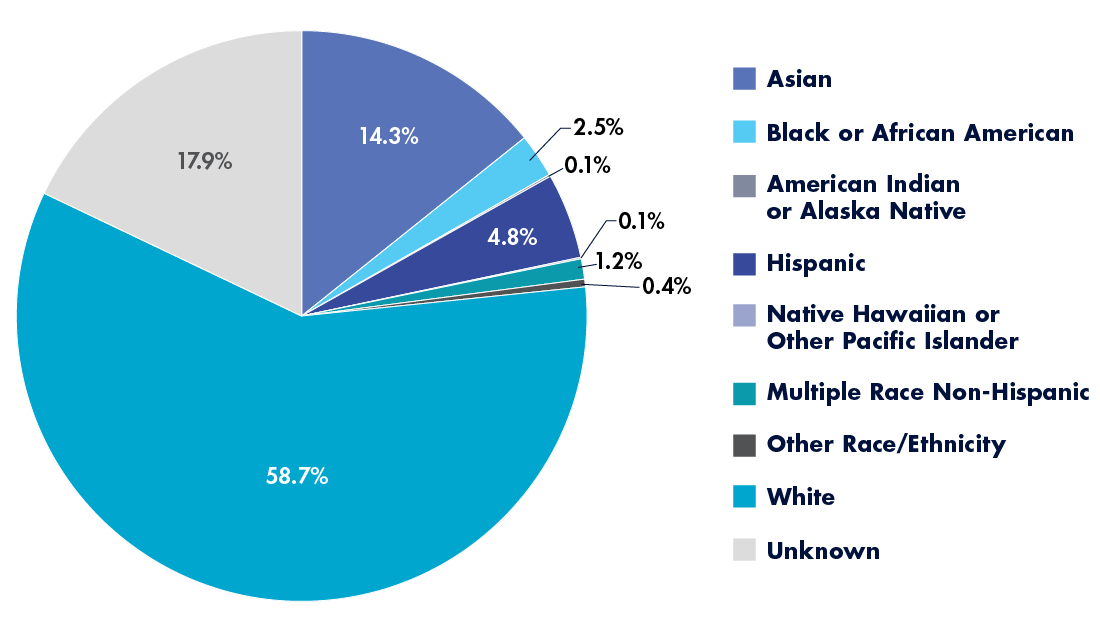Diversity, Equity, and Inclusion: Beyond the Checklist
Working toward greater equity and access to careers in the clinical lab

In recent years, diversity, equity, and inclusion (DEI) efforts have come under the spotlight. Several states have signed into law bills prohibiting public institutions from funding or engaging in formal DEI programs; many others have introduced, but not yet finalized, such legislation.1 Against this turbulent backdrop, how can clinical laboratories continue to make progress in increasing their diversity, ensuring equitable access to lab careers, and creating a welcoming and inclusive environment for all?
A dearth of diversity
For some groups, career equity in the clinical laboratory is a hard-won victory. Women are a steadily increasing proportion of pathology residents and faculty, but remain underrepresented in tenured and high-ranking academic positions.2,3 These numbers reflect the broader picture in medicine, with male faculty predominating, but increasing numbers of women entering the field.4
In other areas of diversity, the lab has made less progress. An Association of American Medical Colleges (AAMC) diversity study revealed that only 2.5 percent of practicing pathologists identified as Black or African American and 4.8 percent as Hispanic (see Figure 1)4 despite these populations making up 13.6 and 19.1 percent of the total US population, respectively.5 Many non-White populations are also underrepresented in other clinical laboratory careers, although the disparity is often reduced. Among medical laboratory scientists, for instance, an estimated 10.8 percent identify as Black or African American and 17.3 percent as Hispanic or Latino;6 for medical laboratory technicians, those numbers are 11.6 and 16.9 percent.7

DEI from the ground up
What can labs do to improve diversity? Inclusive, equitable access to the lab starts at ground level. Many young people interested in science and medicine are unaware of clinical laboratory career options, so never pursue them—but labs can introduce outreach programs to educate the public on their work and capture the attention of interested students. Individual laboratorians can offer mentorships, one-on-one conversations about their work, or even job shadow experiences. Professional associations can support these efforts; many even have programs of their own that provide ambassadorship training and opportunities. Especially in underserved areas, raising awareness of the clinical lab and forming connections with aspiring scientists and doctors can open the door to careers they would never otherwise have considered.8
Diversity and inclusion are key when hiring and training new laboratorians.9 Partnering with organizations designed to support underserved populations can help labs hire employees who reflect the diversity of their area—from writing culturally sensitive job postings to designing accessible interview processes. Onboarding should include education in areas such as cultural awareness, sensitivity, and bias. If possible, labs should offer training in alternative formats as needed; for instance, video-based courses should include closed captions or transcripts for learners who have difficulty accessing or processing audiovisual media.
Building an inclusive lab
For existing lab members, inclusion has many faces.10 Some people may benefit from flexible or alternative scheduling; others may need time off that reflects holidays or observances different from those of the cultural majority. Employees may benefit from internal mentorship arrangements to help them learn new skills or progress to the next stages of their careers. Not all employees will have the same social and cultural context for interactions, so feedback should be gentle, but straightforward to avoid misunderstandings. Labs can also benefit from creating an environment that explicitly welcomes—and demonstrably acts on—feedback so that employees feel safe speaking up to drive improvement in equity and inclusion initiatives.
Mentoring can happen at any career stage, but lab professionals who experience more privilege can often extend those advantages to members of equity-deserving groups. For instance, creating opportunities for low-income teenagers to tour a laboratory and ask questions, providing career advice to a first-generation postsecondary student, or recommending a member of a minority group for an award or presentation can create more visibility for both the clinical laboratory and those interested in pursuing a lab-based career.
Consider documenting or publicizing your laboratory’s DEI work. Written policies or a code of conduct can bring clarity to expectations around workplace inclusion, equity, and respect and can encourage people from equity-deserving groups to explore career opportunities in your lab.11 Ensure that senior leadership are trained in inclusive management skills and open to receiving requests and feedback from any member of the laboratory to make its environment more welcoming, accommodating, and accessible.
Why DEI?
Labs that reflect their communities understand their communities. Without representation, some patient groups may experience delayed or inadequate care or even receive incorrect diagnoses.12,13 Language- or culture-based misunderstandings can impact the clarity and detail of a patient’s history and experiences, making diagnosis and treatment more challenging. The focus on those groups’ priorities may decrease, reducing the overall quality of healthcare delivery—a problem that ultimately affects every patient.
Prioritizing DEI can even help strengthen the health of the laboratory itself. Research suggests that, although burnout and other mental health concerns are prevalent among laboratorians, specific groups—including women, people of color, and those with disabilities—experience more discrimination and higher levels of stress.14 Initiatives that drive greater inclusion and equity among clinical laboratory professionals can help alleviate these issues, relieving pressure on individuals and improving overall laboratory performance.
The take-home message? “Diversity and inclusion in the lab are not just ethical imperatives; they’re catalysts for innovation,” says Kamran M. Mirza, Godfrey D. Stobbe Professor and assistant chair of pathology education at the University of Michigan. “By implementing mentorship programs, providing bias training, and recruiting from underrepresented groups, labs can foster an environment where every member feels valued and empowered. DEI provides multiple lenses to view and solve problems. This approach doesn’t just elevate our work; it ensures that our scientific advancements reflect and serve our diverse society more effectively.”
References:
- Bryant J, Appleby C. These States’ Anti-DEI Legislation May Impact Higher Education. Best Colleges. April 3, 2024. https://www.bestcolleges.com/news/anti-dei-legislation-tracker.
- White MJ et al. Current and historical trends in diversity by race, ethnicity, and sex within the US pathology physician workforce. Am J Clin Pathol. 2020;154(4):450–458. doi:10.1093/ajcp/aqaa139.
- Tanvir I et al. Ethnic and gender diversity in pathology: a dream deferred. Cureus. 2023;15(5):e38528. doi:10.7759/cureus.38528.
- American Association of Medical Colleges. Diversity in Medicine: Facts and Figures 2019. https://www.aamc.org/data-reports/workforce/report/diversity-medicine-facts-and-figures-2019.
- United States Census Bureau. QuickFacts. July 1, 2023. https://www.census.gov/quickfacts/fact/table/US/PST045223.
- Zippia. Medical laboratory scientist demographics and statistics in the US. July 21, 2023. https://www.zippia.com/medical-laboratory-scientist-jobs/demographics.
- Zippia. Medical laboratory technician demographics and statistics in the US. July 21, 2023. https://www.zippia.com/medical-laboratory-technician-jobs/demographics.
- Swails K. The Importance of a Diverse Laboratory. Critical Values. October 4, 2022. https://criticalvalues.org/news/all/2022/10/04/the-importance-of-a-diverse-laboratory.
- Maness L, Conway-Klaassen J. Best practices for maintaining diverse laboratories. Clin Lab Sci. 2017;30(1):51 –54. doi:10.29074/ascls.30.1.51.
- Robinson S. Diversity, Equity, and Inclusion in My Lab. ASCLS Today. February 2022. https://ascls.org/diversity-equity-and-inclusion-in-my-lab.
- Ryerson University. Supporting Equity, Diversity and Inclusion (EDI) in your Research Group and Research Activities. https://www.torontomu.ca/content/dam/science/Faculty-of-Science-Dimensions-Program_Some-Resources-to-Support=EDI-in-your-SRC.pdf.
- Vyas DA et al. Hidden in plain sight — reconsidering the use of race correction in clinical algorithms. N Engl J Med. 2020;383(9):874–882. doi:10.1056/NEJMms2004740.
- Szabo L. Women and minorities bear the brunt of medical misdiagnosis. KFF Health News. January 18, 2024. https://kffhealthnews.org/news/article/medical-misdiagnosis-women-minorities-health-care-bias.
- Mulder L et al. Examining the role of diversity, equity, and inclusion in mitigating workforce burnout in laboratory medicine. Am J Clin Pathol. 2024;161(2):130–139. doi:10.1093/ajcp/aqad123.
Subscribe to Clinical Diagnostics Insider to view
Start a Free Trial for immediate access to this article